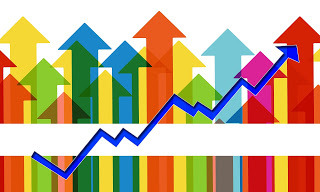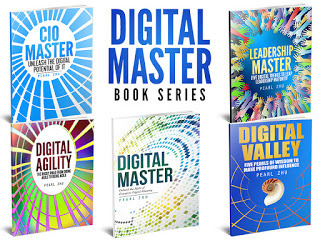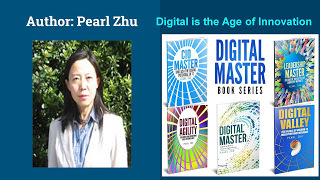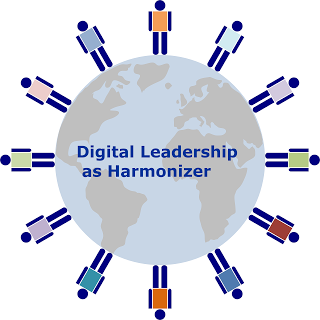Pearl Zhu's Blog, page 1325
June 23, 2016
The Weekly Insight of the “Future of CIO” 6/23/2016
 The “Future of CIO” Blog has reached 1.3 million page views with 2900+ blog posting in 59+ different categories of leadership, management, strategy, digitalization, change/talent, etc. The content richness is not for its own sake, but to convey the vision and share the wisdom. Here is the weekly insight about digital leadership, IT Management and Talent Management.
The “Future of CIO” Blog has reached 1.3 million page views with 2900+ blog posting in 59+ different categories of leadership, management, strategy, digitalization, change/talent, etc. The content richness is not for its own sake, but to convey the vision and share the wisdom. Here is the weekly insight about digital leadership, IT Management and Talent Management.
The Weekly Insight of the “Future of CIO” 6/23/2016To Celebrate 2900 Blog Posting in “Future of CIO”: Blogging is not about writing, but about thinking and innovating the new ideas; it’s not just about WHAT to say, but about WHY to say, and HOW to say it. It reflects the color and shade of your thought patterns, and it indicates the peaks and curves of your thinking waves.
“Digital Master” Book Series Introduction The Digital transformation, like the computer technology revolution itself, is a long journey. “Digital Master” is the series of guide books (5+ Books) to perceive the multi-faceted impact digital is making to the business and workforce, and help forward-looking businesses to navigate through journey in a holistic way.
“Digital Agility” Book Introduction Chapter 5: Agile Dot Connections: Agile is not only the ability to create changes, but also the capability to adapt to changes, and create a working environment to inspire creativity. If creativity is all about connecting the dots, and agility is about shaping a customer-centric organization with a culture of innovation. And then, how can we connect the dots between agile and other desired goals of the digital organization, such as strategy, quality, flexibility, innovation, etc. Because Agile is certainly not just a “development thing,” the goals of agile transformation lie with the organizations to overall improve organizational maturity.
The Monthly CIO Debates Collection Running IT with Digital Speed June 2016 Due to the changing nature of technology, IT leadership role also continues to involve & shift the focus, to move up the maturity level. More and more CIOs are requested to take more responsibility and many CIOs present the breadth of leadership competency. The proactive IT debates help IT leaders to brainstorm innovative and better ways to do things, and improve management capabilities. Here are the monthly CIO debates collections.
 “Digital Agility” Book Introduction Chapter 7 Agile Maturity: Many organizations are transforming from doing Agile to being agile, apply agile philosophy, methodology, and practices to scaling up and building a truly agile organization is an important aspect of digital transformation. But what characteristics determine whether organizations are truly agile or just calling themselves agile? How do you define Agile maturity? And how to build a high-mature Agile organization?
“Digital Agility” Book Introduction Chapter 7 Agile Maturity: Many organizations are transforming from doing Agile to being agile, apply agile philosophy, methodology, and practices to scaling up and building a truly agile organization is an important aspect of digital transformation. But what characteristics determine whether organizations are truly agile or just calling themselves agile? How do you define Agile maturity? And how to build a high-mature Agile organization?Running Lightweight Digital IT to Catalyze Digital Transformation Organizations large or small are on the journey of digital transformation. Literally transformation is to radically change the nature of something. So digital transformation is a radical change of business, leverage digital technologies to renovate business processes, innovate organizational culture, reinvent digital leadership, reimagine the new possibilities and unleash the full business potential of the company. Forward-looking organizations are also empowering their IT leaders to lead more proactively and take advantage of lightweight digital technology to catalyze digital transformation.
Running a Highly Capable Digital IT Forward-looking IT organizations are shifting from a process-driven silos function to a capability-based digital engine of the organization, because often technology is the disruptive force of business transformation, and the information is one of the most valuable assets in modern business. IT needs to go beyond “keeping the light on,” and focus on adding value to catalyze business growth and improve organizational maturity. More specifically, how to run a highly capable digital IT?
Blogging is not about writing, but about thinking and innovating the new ideas; it’s not just about WHAT to say, but about WHY to say, and HOW to say it. It reflects the color and shade of your thought patterns, and it indicates the peaks and curves of your thinking waves. Unlike pure entertainment, quality and professional content takes time for digesting, contemplation and engaging, and therefore, it takes the time to attract the "hungry minds" and the "deep souls." It’s the journey to amplify diverse voices and deepen digital footprints, and it's the way to harness your innovative spirit.
Follow us at: @Pearl_Zhu
Published on June 23, 2016 23:27
“Digital Agility” Quote Collection II
 16 The solution to encourage creativity is to maximize use of employee brainpower.
16 The solution to encourage creativity is to maximize use of employee brainpower.
17 Build a good quality product and create sufficient documentation, but don’t focus on make the document super flashy.
18 Every system is a construct of the mind. System wisdom is more as philosophical wisdom rather than just scientific intelligence.
19 Self-organization directs the individual perspectives into creative, adaptive, iterative and incremental problem-solving approach.
20 Overall speaking, you should always be picking up stories which have the highest business value or customer needs.
21 Agile is both philosophy and methodology, mindset and framework.
22 At the top level, Agile needs to be the philosophy to perceive multidimensional business values.
23 The focus of structure experiment needs always to be on exploring the various pathways towards desired goals.
24 Agile is the practice for both eliminating unproductive complexity, and enforcing productive complexity.
25 Innovation Agility enables people to see and solve problems in flexible and adaptive ways.
26 “Knowledge on demand” is about making all types of data and information accessible in situations and context as needed.
27 The benefits of agility are not sustainable unless engineering practices are adopted in the earnest.
28 The best way to fail Agile is thinking that you will implement agile inside a business unit without taking into account the whole enterprise.
29 Agile doesn’t fail, people do.
30 Agile is more a “direction,” than an “end.” Transforming to Agile culture means the business knows the direction they want to go on.Follow us at: @Pearl_Zhu
Published on June 23, 2016 23:23
A Reflective Board
 Digital means change. The changes are touching every industry and activity, they have yet to produce a wave of response at board level as well. The contemporary corporate board as top leadership team plays a significant role in oversight business strategy, make appropriate policies and exemplify leadership effectiveness. Although the majority of BoDs are senior leaders with industrial expertise and knowledge, in order to adapt to changes, they have to be in a continuous self-reflective mode to make objective assessment on board competency, effectiveness and performance.
Digital means change. The changes are touching every industry and activity, they have yet to produce a wave of response at board level as well. The contemporary corporate board as top leadership team plays a significant role in oversight business strategy, make appropriate policies and exemplify leadership effectiveness. Although the majority of BoDs are senior leaders with industrial expertise and knowledge, in order to adapt to changes, they have to be in a continuous self-reflective mode to make objective assessment on board competency, effectiveness and performance.
Board competency: The composition of Boards should reflect approximately the profile of the company' stakeholders: shareholders, employees, customers, and suppliers. The digital Board is responsible for ensuring an appropriate mix of skills, knowledge and experience are present or available for it to fulfill its function. High-competitive Boards should look for people who have cognitive difference or unique strength as part of the mix of Board skills, for business growth and embrace trend such as digitalization and globalization. There is a need for both Generalists and Specialists - the Generalists can give an overview while the Specialist can "drill down" into specific topics. It's all a matter of teamwork.There is much to be done in terms of having appropriate competencies around the board table to deal with all aspects of governance responsibility, including IT.
Board effectiveness: An effective and efficient Board can reflect, identify and mind the gaps on their own Board room turf: Such as purpose, culture, leadership, information, advice, debate, and self-renewal. The non-executive members should be selected for their ability and willingness to constructively challenge management and this is less likely to happen if they are related to, or are close pals of, the executive members. Self-reflection also helps the board to improve leadership effectiveness. Board must set an example of leadership which permeates through the entire organization. How they do it or rather how each member of the board does it, depends on only one thing- Individualism or Collectivism nature. It is combining a range of value creating, motivating, value protecting and monitoring strategies rather than following best practice heuristics. A reflective board can leverage its own strength, tailor its own specific needs, and develop the next practices to digitize board room.
 Board Learning agility: A reflective board can encourage each BoD to learn, contribute, and fulfill the purpose of participation. Board members should be joining the boards because they have the strong intent and learning agility to contribute to the maximization of the company's full potential and are unwilling to settle for anything less. They have a learning mind to absorb all necessary knowledge, abstract it into insight and capture the wisdom. Directors of the Board with insight have a responsibility and be more skillful to ask ‘right’ questions. They need to go beyond "understanding the strategy" to a deep dive into the businesses to further understanding the culture, business capability, and competency, etc. Only by doing this, can the board genuinely understand the value creation opportunities and risks available to the company which will then enable the board to engage with management in the development of a value maximization plan. A reflective board with learning agility then can guide the business, not to take the shortcut, but to steer in the right direction.
Board Learning agility: A reflective board can encourage each BoD to learn, contribute, and fulfill the purpose of participation. Board members should be joining the boards because they have the strong intent and learning agility to contribute to the maximization of the company's full potential and are unwilling to settle for anything less. They have a learning mind to absorb all necessary knowledge, abstract it into insight and capture the wisdom. Directors of the Board with insight have a responsibility and be more skillful to ask ‘right’ questions. They need to go beyond "understanding the strategy" to a deep dive into the businesses to further understanding the culture, business capability, and competency, etc. Only by doing this, can the board genuinely understand the value creation opportunities and risks available to the company which will then enable the board to engage with management in the development of a value maximization plan. A reflective board with learning agility then can guide the business, not to take the shortcut, but to steer in the right direction.Governance is a sophisticated process that if well executed, will lead to better decisions. It will allow not only to keep the existing value but also to create new value for its shareholders. Therefore, a reflective board can examine the board composition, competency, and performance periodically, better adapt to changes, make influence on business culture, exemplify leadership effectiveness, make continuous improvement, and experiment the next practices for digital transformation at the boardroom.
Follow us at: @Pearl_Zhu
Published on June 23, 2016 23:21
“CIO Master” Book Tuning: The Interdisciplinary Practice to Manage IT and Business
 Businesses today are shifting from the industrial silo mode to the hyper-connected digital mode. Therefore, the business management style should also shift from hierarchical command and control style to practice holistic management philosophy via interdisciplinary approach. The Interdisciplinary science can be applied to management with integrating multi-disciplinary methodology, it enables leaders to frame a bigger thinking boxes, and approach problems via multi-faceted way, technically, scientifically and culturally.
Businesses today are shifting from the industrial silo mode to the hyper-connected digital mode. Therefore, the business management style should also shift from hierarchical command and control style to practice holistic management philosophy via interdisciplinary approach. The Interdisciplinary science can be applied to management with integrating multi-disciplinary methodology, it enables leaders to frame a bigger thinking boxes, and approach problems via multi-faceted way, technically, scientifically and culturally.
Non-linearity: There are two different philosophical approaches for managing businesses; in the industrial era, the majority of organizations apply reductionism -break a problem into parts, solve each part separately, add up results, this approach can achieve the certain level of business efficiency. However, digital break down the functional border, geographical, or even organizational border, businesses today become much nonlinear, interconnected and interdependent than ever. Therefore, the positive approach comes from attempting to isolate and understand the dynamics of the individual functions in the enterprise, some of which for the time frame will be as good as linear, but more often, the organization as a whole has to function more holistically and coherently. When systems are not linear, they are defined as nonlinear. It is necessary to integrate their interdependencies if they exist, hence, holism -the whole is different from the sum of the parts need to become the management philosophy to run today’s business.
Adaptability, unrepeatability, unpredictability: Digital also means the rapidly change, and unprecedented level of unrepeatability and unpredictability. The ability of companies to consume and make sense of the information that is available to make good decisions within today’s digital dynamic with unrepeatability and unpredictability is becoming a nearly insurmountable challenge. The problem to be solved is to deal with this mountain of information with both technology and human know-how, then to convert this information into valuable knowledge and precious insight in handling business uncertainty more effectively. While there is always some remaining uncertainty, reducing the uncertainty, particularly if one broadly involves the organization, leads to better decisions / strategic plans and better implementation. This does not ensure success, but it does raise the probability of success.
 Strategy-execution continuum: Digital strategy needs to be more dynamic in order to capture the emergent opportunities - Admit those disruptive events may occur. Learn to stay alert and to observe with subtlety and learn fast. It’s about agile strategy-execution continuum. It's not all about "making a strategy" as end-product, but about implementing it afterward. It is also about communicating about the quality of the strategy, saying openly what is known and what is not. the challenges, competition & complexities may be in on the increase but along with it there comes the increase in opportunity too and in the form of demand. For most of organizations, they still do have contexts of relative certainty, while simultaneously having contexts reflecting both complexity and chaos.Each of these contexts requires a different management approach. There are two important things that will be important in the interdisciplinary management. First, it is gaining the knowledge necessary to understand and manage holistic digital ecosystems. Secondly, the most challenging one is to understanding how the people factor affects the business system--and--then managing the complex system and the people of the complex system. Understand that dynamic business development is multifaceted. You can't expect an individual to fully develop such broad based concepts, it takes team effort, and more importantly, team coordination.
Strategy-execution continuum: Digital strategy needs to be more dynamic in order to capture the emergent opportunities - Admit those disruptive events may occur. Learn to stay alert and to observe with subtlety and learn fast. It’s about agile strategy-execution continuum. It's not all about "making a strategy" as end-product, but about implementing it afterward. It is also about communicating about the quality of the strategy, saying openly what is known and what is not. the challenges, competition & complexities may be in on the increase but along with it there comes the increase in opportunity too and in the form of demand. For most of organizations, they still do have contexts of relative certainty, while simultaneously having contexts reflecting both complexity and chaos.Each of these contexts requires a different management approach. There are two important things that will be important in the interdisciplinary management. First, it is gaining the knowledge necessary to understand and manage holistic digital ecosystems. Secondly, the most challenging one is to understanding how the people factor affects the business system--and--then managing the complex system and the people of the complex system. Understand that dynamic business development is multifaceted. You can't expect an individual to fully develop such broad based concepts, it takes team effort, and more importantly, team coordination.
The purpose of managing business via interdisciplinary discipline is to ensure that the business as a whole is superior to the sum of pieces. To engage and function in complex environments, it requires fundamentally different mindsets and paradigms such as accepting that influence is attainable, but control is not. It needs to leverage information to overcome uncertainty and unpredictability, and it takes a holistic approach to unleash the digital potential of today’s organization.
Follow us at: @Pearl_Zhu
Published on June 23, 2016 23:18
June 22, 2016
"Digital Master" Book Series (5+ Books) Introduction: A Set of Guide Books to Help you Become “Digital Ready”
 The Digital transformation, like the computer technology revolution itself, is a long journey. The outlines of the fully digitalized world have long been sketched, now the phenomenon of digital is reaching the inflection point, yet we are now entering an even more rapid and extensive period of change. As this notion of “digitization” is now affecting all aspects of business operations from innovation within and around business ecosystem to customer engagement, to business models and processes – and no industry is exempt. Hence, most companies naturally aim to move into a more advanced stage of digital deployment by tailoring their own unique strength and business maturity. They hope to outstrip competitors and eventually become the digital masters.Digital-Ready Leadership: The substance of leadership never changes, it’s all about making positive influences, and providing direction, both for oneself and others. Leadership is about CHANGE. It is a basic human ability to inspire self and others to look beyond limitations and make continuous improvement. This ability becomes a capability if we constantly nurture our basic human instincts of humility, curiosity, and creativity. Digital leadership is less about "HOW," more about "WHY," and “WHAT.” Leadership brand is less about what you look - the stereotypical leadership, and more about what you think - Thought Leadership. Great leaders are pioneers, innovators, and creators of a better context. Creative leadership is the unique combination of a growth mindset and leadership behaviors that develop and achieves high-quality results over a sustained period of time and risk tolerance. Top leaders are also visionary roles, they set the direction for the enterprise (internal and/or external) to step into the uncharted water, and they orchestrate the digital transformation of an organization, its people, a vision of the future is the key to getting started as a digital leader. The authentic leaders with high and multi-intelligence have inquisitiveness, adaptability, consistency, and empathy to master business dynamic and cultural cognition. They present the ability and wisdom to manage complexity in high digital transparency and stressful digital dynamic. A mindful or thoughtful leader has a better perception to be a good communicator upon thinking profoundly, upon knowing when to voice out, when to keep silent; upon striking the right balance without any sort of extreme thinking or bias.
The Digital transformation, like the computer technology revolution itself, is a long journey. The outlines of the fully digitalized world have long been sketched, now the phenomenon of digital is reaching the inflection point, yet we are now entering an even more rapid and extensive period of change. As this notion of “digitization” is now affecting all aspects of business operations from innovation within and around business ecosystem to customer engagement, to business models and processes – and no industry is exempt. Hence, most companies naturally aim to move into a more advanced stage of digital deployment by tailoring their own unique strength and business maturity. They hope to outstrip competitors and eventually become the digital masters.Digital-Ready Leadership: The substance of leadership never changes, it’s all about making positive influences, and providing direction, both for oneself and others. Leadership is about CHANGE. It is a basic human ability to inspire self and others to look beyond limitations and make continuous improvement. This ability becomes a capability if we constantly nurture our basic human instincts of humility, curiosity, and creativity. Digital leadership is less about "HOW," more about "WHY," and “WHAT.” Leadership brand is less about what you look - the stereotypical leadership, and more about what you think - Thought Leadership. Great leaders are pioneers, innovators, and creators of a better context. Creative leadership is the unique combination of a growth mindset and leadership behaviors that develop and achieves high-quality results over a sustained period of time and risk tolerance. Top leaders are also visionary roles, they set the direction for the enterprise (internal and/or external) to step into the uncharted water, and they orchestrate the digital transformation of an organization, its people, a vision of the future is the key to getting started as a digital leader. The authentic leaders with high and multi-intelligence have inquisitiveness, adaptability, consistency, and empathy to master business dynamic and cultural cognition. They present the ability and wisdom to manage complexity in high digital transparency and stressful digital dynamic. A mindful or thoughtful leader has a better perception to be a good communicator upon thinking profoundly, upon knowing when to voice out, when to keep silent; upon striking the right balance without any sort of extreme thinking or bias.
Digital Ready DNA: All organizations have a culture. That culture is a display of collective behavior. It is influenced and shaped by the interaction between employees, management, and their environment. The result is a set of norms and values that determine how people will behave and relate to one another in a particular setting. Culture is a mindset, attitude, and competency of an organization. Changing the organizational culture, however, is not so easily done because traditions are closely held as norms, values, and beliefs. In addition, the nature of organizational structure—the hierarchy—can slow the process of review and adaptation. Culture is part passion, part commitment, and part faith. It's the synergy of the team, the managers and business leaders. Therefore, a cohesive culture creates team synergy, catalyze digital transformation and improve overall organizational maturity.
Digital Ready Capabilities: The business capability is at a higher level than business process, and it is in the conceptual layer. Digital capability is synthetic in nature, embedding agility in processes and focusing on long-term competency. Digital capabilities cut across all functional pillars. They are fundamental building blocks for business transformation. 6. The core business capabilities are an integrated set of capabilities contribute directly to the competitive advantage of the business. In today’s business dynamic, digital capabilities are a fundamental building block in digital transformations with which companies can transform customer experiences, operational processes, and business models, to reach high-level business agility and maturity. The often described business capabilities include such as robustness, speed, comprehensiveness, responsiveness, agility, improvement, sensitivity, optimization, resilience, etc.
 “Digital Master” is the series of guidebooks to perceive the multi-faceted impact digital is making to the business and workforce, and navigate the business and digital professionals toward the journey with “digital readiness”: Digital Master -Debunk the Myths of Enterprise Digital Maturity: It's a comprehensive frame book to guide forward-looking organizations towards a smooth digital transformation via taking a holistic approach. CIO Master -Unleash Digital Potential of IT: It's a play book to run a highly effective, highly innovative and highly mature digital IT organization.Digital Valley - Five Pearls of Wisdom to Make Profound Influence: It's a guide book to understand wisdom from multidimensional lenses.Digital Agility - The Rocky Road from Doing Agile to Being Agile: It's an informative book to share the insight about agile philosophy and mindsets, best practices, pitfalls, dots connection, and debates etc. Leadership Master - Five Digital Trends to Leap Leadership Maturity: It is a bridge book to convey the vision of digital leadership, and summarize five emergent digital leadership trends to bridge the industrial age and the digital Era.Digitalization is like a flywheel, and Digital Masters are the one riding above it. They are the organizations or individuals that have rich digital insight and high-level digital capability, not only to initiate enterprise-wide digital innovations but also have their very nature of digital influence or digital “persona”: they are strong digital business leaders or champions with their own unique strength and style.Digital Master Book Series Slideshare Presentation"Digital Master" Book Series Amazon Order Link"Digital Master" Book SeriesB&N Order Link"Digital Master" Book Series IBook Order Link
“Digital Master” is the series of guidebooks to perceive the multi-faceted impact digital is making to the business and workforce, and navigate the business and digital professionals toward the journey with “digital readiness”: Digital Master -Debunk the Myths of Enterprise Digital Maturity: It's a comprehensive frame book to guide forward-looking organizations towards a smooth digital transformation via taking a holistic approach. CIO Master -Unleash Digital Potential of IT: It's a play book to run a highly effective, highly innovative and highly mature digital IT organization.Digital Valley - Five Pearls of Wisdom to Make Profound Influence: It's a guide book to understand wisdom from multidimensional lenses.Digital Agility - The Rocky Road from Doing Agile to Being Agile: It's an informative book to share the insight about agile philosophy and mindsets, best practices, pitfalls, dots connection, and debates etc. Leadership Master - Five Digital Trends to Leap Leadership Maturity: It is a bridge book to convey the vision of digital leadership, and summarize five emergent digital leadership trends to bridge the industrial age and the digital Era.Digitalization is like a flywheel, and Digital Masters are the one riding above it. They are the organizations or individuals that have rich digital insight and high-level digital capability, not only to initiate enterprise-wide digital innovations but also have their very nature of digital influence or digital “persona”: they are strong digital business leaders or champions with their own unique strength and style.Digital Master Book Series Slideshare Presentation"Digital Master" Book Series Amazon Order Link"Digital Master" Book SeriesB&N Order Link"Digital Master" Book Series IBook Order LinkFollow us at: @Pearl_Zhu
Published on June 22, 2016 23:10
The Book “Digital Agility” Quote Collection
 Agile is a state of mind, not a process.The agile way is customer-centric, purpose-driven, capability-based and talent-oriented.Critical thinking has the potential to be a deeply creative process.The “state of mind” is a big part of the agile transformation.Systemicness of agile means to leverage Systems Thinking not only in the context of the individual project, but also to be considered at the enterprise level.Learning agility means to learn, delearn, and relearn all the times.
Agile is a state of mind, not a process.The agile way is customer-centric, purpose-driven, capability-based and talent-oriented.Critical thinking has the potential to be a deeply creative process.The “state of mind” is a big part of the agile transformation.Systemicness of agile means to leverage Systems Thinking not only in the context of the individual project, but also to be considered at the enterprise level.Learning agility means to learn, delearn, and relearn all the times.Doing agile is a set of activities, but being agile is the state of mind, the ongoing capability and the cultural adaptability.Orchestrating a diversified team can indeed enhance the higher level of harmony.Accountability means to say what you do, do what you say.Agile is more a “direction,” than an “end.” Transforming to Agile culture means the business knows the direction they want to go on. 11 In essence, Agile is a philosophy and a set of principles. 12 The success agile formula: Good people + average process = Success Great people + average process = Guarantees Success 13 One of the reasons to see improved productivity in Agile is because of the simplicity principle. 14 Principles are those core decisions values, not value as in benefit, but values as in beliefs that shape behavior and define culture.
15 Agile is not prescriptive and which techniques are appropriate will depend on the context.
Follow us at: @Pearl_Zhu
Published on June 22, 2016 22:59
“Leadership Master” Book Conclusion: Digital Leadership as Harmonizer
 We slowly, but steadily move the the digital era with an abundance of knowledge and flow of information and ideas, digital leadership is about harmonizing and orchestrating toward the next level of prosperity and leap to the next level of maturity with the following trends and traits:
We slowly, but steadily move the the digital era with an abundance of knowledge and flow of information and ideas, digital leadership is about harmonizing and orchestrating toward the next level of prosperity and leap to the next level of maturity with the following trends and traits:
A digital leader is a visionary: Due to the “VUCA” characteristics of digital new normal, digital leaders need to be visionary to help businesses navigate through the uncharted water and blurred digital borders. Leadership is one’s ability to paint a vivid picture, a vision of a future state and motivate others to achieve it. For better or worse, leadership is a very complex subject which includes a myriad of hard business skills along with the soft skills of leadership and interpersonal behaviors.
A digital leader is progressive: Nobody, including leaders are perfect. Any leader who is willing to admit “I’ve made mistakes in the past,” or “I am still learning how to do this better,” is going to be approachable and set the right example for others to follow. And most people are looking for leaders who make progress, rather than perfection.
 A digital leadership is a great coach: Leaders understand what failure is, but they inspire a culture of innovation with calculated risk tolerance. The role of a leader is to create conditions that encourage and enable others to dedicate their collective intelligence, talent, and full energy to achieve extraordinary result. Leaders are sure enough in themselves to know what they don’t know and trust their own judgment of others to empower those around them to make an organization successful.
A digital leadership is a great coach: Leaders understand what failure is, but they inspire a culture of innovation with calculated risk tolerance. The role of a leader is to create conditions that encourage and enable others to dedicate their collective intelligence, talent, and full energy to achieve extraordinary result. Leaders are sure enough in themselves to know what they don’t know and trust their own judgment of others to empower those around them to make an organization successful.Leadership is a journey from good to great. Greatness is what you overcome. The difficult situations, challenges, problems, all those things that make you suffer lead you greatness if you could overcome and learn from them. The digital leadership trends and traits described in this book are defining qualities that will distinguish great leaders from the rest, to go deeper, beyond a status quo, it’s about harmonizing and orchestrating an innovative organization and peaceful society. And harmonization is the digital leadership them to leapfrog leadership maturity.Follow us at: @Pearl_Zhu
Published on June 22, 2016 22:56
"CIO Master" Book Tuning XXXVIIII: How to Unleash Digital Potential of IT
Digital IT is not only faster and lighter but also smarter and insightful.
 Digital technology is faster, lighter, and cheaper. Digital IT can unleash its full potential when technology embraces the art, creativity meets agility, and IT maturity is lifted from functioning to delight via interaction, innovation, and intelligence.
Digital technology is faster, lighter, and cheaper. Digital IT can unleash its full potential when technology embraces the art, creativity meets agility, and IT maturity is lifted from functioning to delight via interaction, innovation, and intelligence.
Interaction: At the industrial Era, IT is perceived as a support center to take the order from the business. If the business only regards IT as a support function, then the priority will be operational efficiency. Such view surely limits the vision to unleash the digital potential of IT, especially right now, technology is often the disruptive force of digitalization and information is the gold mine to catalyze business growth. At the dawn of the Digital Era, IT needs to become a strategic partner of the business, there must be a very clear understanding and agreement between IT and the business about the role of IT in the organization. Both business and IT have to stay on the same page about strategy and weave IT into business strategy, in order to build a bridge between IT and business. The connection between IT and business lies in using the language to help business cross that bridges to IT. If the business expects IT to be a driver of innovation and change then the IT function needs to be flexible and responsive and even proactive. The business needs to know what IT can deliver and enter a dialogue about what best serves the goals of the business. Getting to this stage can take many years, but in order to get there, IT needs to be telling business about the opportunities and possibilities and that means IT needs to really understand the goals of the business.
Innovation: Often IT department are so busy in mundane day to day activities, they lose the sense of creativity over the period of time. Hence, CIOs have to learn the right and real things about organizations, not just via IT lenses, but via business lenses and customer viewpoint. Customer Centric organization means very different things to different people. Customer experience comes from all touch points, yet industrial organizations are structured by department silos and it hinders company’s ability to create value. To run an innovative IT, it’s critical to listen, comprehend and understand the people and the business they are part of, before embarking on any new way of thinking to know where you have come from enables you to move to a new place even quicker. The innovative way for IT/technology to help win customers’ heart is to make most of IT and technology "invisible" to the customer. In other words, hide the complexity of IT/technology infrastructure & operations. What is left visible to the customer should be simple, intuitive, secure, reliable and predictable business solutions. This requires a cross-functional customer-centric paradigm for managing and operating IT/technology. Digital IT can drive all sort of innovations, proactively pushing ideas on how to leverage technology to drive revenue growth, increase business productivity, flexibility, and agility.
 Intelligence: Digital IT is not only faster and lighter but also smarter and insightful. IT is shifting from a technology custodian to an information steward. Information Management makes information available and useful, exert lots of intelligence to capture customer insight and business foresight. The intention of Eco-Information Management Life Cycle (Data-Information-Knowledge-Insight- Wisdom) is to build a high intelligent organization via capturing insight & foresight in making the right business decisions timely and bringing profits to the organization for the long term. Information applies to the context and environment in which decisions are made. IT is also a change agent to advocate data-based culture and lead the organization to the age of insight and intelligence.
Intelligence: Digital IT is not only faster and lighter but also smarter and insightful. IT is shifting from a technology custodian to an information steward. Information Management makes information available and useful, exert lots of intelligence to capture customer insight and business foresight. The intention of Eco-Information Management Life Cycle (Data-Information-Knowledge-Insight- Wisdom) is to build a high intelligent organization via capturing insight & foresight in making the right business decisions timely and bringing profits to the organization for the long term. Information applies to the context and environment in which decisions are made. IT is also a change agent to advocate data-based culture and lead the organization to the age of insight and intelligence.
IT is the business, to unleash the digital potential of IT, organizations need to understand that IT is not just technical or scientific, but also artistic and delightful, and it can digitize every touch point of customer experience, it can also generate revenue and influence business decisions. IT leaders can identify the critical business issues by working closely with business partners from a long-term perspective, and leverage technology to improve interactive communication, enforce innovation management, and capture business insight across the enterprise boundary.
CIO Master Order Link on Amazon CIO Master Ordre Link on Barner & Noble CIO Master Order Link On IBooks “CIO Master” Book Preview Quote Collection III “CIO Master” Book Preview Quote Collection II “CIO Master” Book Preview Quote Collection I, Slideshare Presentation “CIO Master” Book Preview Conclusion Running IT as Digital Transformer “CIO Master” Book Preview: Chapter 9 IT Agility “CIO Master” Book Preview: Chapter 8 Three "P"s in Running Digital IT “CIO Master” Book Preview: Chapter 7 IT Innovation Management “CIO Master” Book Preview: Chapter 6 Digital Strategy-Execution Continuum "CIO Master” Book Preview: Chapter 5 Thirteen Digital Flavored IT “CIO Master” Book Preview: Chapter 4 CIO as Talent Master Introduction “CIO Master” Book Preview: Chapter 3 “CIOs as Change Agent” Introduction “CIO Master” Book Preview: Chapter 2 “CIOs as Digital Visionary” Introduction “CIO Master” Book Preview: Chapter 1 “Twelve Digital CIO Personas” Introduction "CIO Master - Unleash the Digital Potential of IT" Introduction "CIO Master - Unleash the Digital Potential of IT" Book Preview
Follow us at: @Pearl_Zhu
 Digital technology is faster, lighter, and cheaper. Digital IT can unleash its full potential when technology embraces the art, creativity meets agility, and IT maturity is lifted from functioning to delight via interaction, innovation, and intelligence.
Digital technology is faster, lighter, and cheaper. Digital IT can unleash its full potential when technology embraces the art, creativity meets agility, and IT maturity is lifted from functioning to delight via interaction, innovation, and intelligence.
Interaction: At the industrial Era, IT is perceived as a support center to take the order from the business. If the business only regards IT as a support function, then the priority will be operational efficiency. Such view surely limits the vision to unleash the digital potential of IT, especially right now, technology is often the disruptive force of digitalization and information is the gold mine to catalyze business growth. At the dawn of the Digital Era, IT needs to become a strategic partner of the business, there must be a very clear understanding and agreement between IT and the business about the role of IT in the organization. Both business and IT have to stay on the same page about strategy and weave IT into business strategy, in order to build a bridge between IT and business. The connection between IT and business lies in using the language to help business cross that bridges to IT. If the business expects IT to be a driver of innovation and change then the IT function needs to be flexible and responsive and even proactive. The business needs to know what IT can deliver and enter a dialogue about what best serves the goals of the business. Getting to this stage can take many years, but in order to get there, IT needs to be telling business about the opportunities and possibilities and that means IT needs to really understand the goals of the business.
Innovation: Often IT department are so busy in mundane day to day activities, they lose the sense of creativity over the period of time. Hence, CIOs have to learn the right and real things about organizations, not just via IT lenses, but via business lenses and customer viewpoint. Customer Centric organization means very different things to different people. Customer experience comes from all touch points, yet industrial organizations are structured by department silos and it hinders company’s ability to create value. To run an innovative IT, it’s critical to listen, comprehend and understand the people and the business they are part of, before embarking on any new way of thinking to know where you have come from enables you to move to a new place even quicker. The innovative way for IT/technology to help win customers’ heart is to make most of IT and technology "invisible" to the customer. In other words, hide the complexity of IT/technology infrastructure & operations. What is left visible to the customer should be simple, intuitive, secure, reliable and predictable business solutions. This requires a cross-functional customer-centric paradigm for managing and operating IT/technology. Digital IT can drive all sort of innovations, proactively pushing ideas on how to leverage technology to drive revenue growth, increase business productivity, flexibility, and agility.
 Intelligence: Digital IT is not only faster and lighter but also smarter and insightful. IT is shifting from a technology custodian to an information steward. Information Management makes information available and useful, exert lots of intelligence to capture customer insight and business foresight. The intention of Eco-Information Management Life Cycle (Data-Information-Knowledge-Insight- Wisdom) is to build a high intelligent organization via capturing insight & foresight in making the right business decisions timely and bringing profits to the organization for the long term. Information applies to the context and environment in which decisions are made. IT is also a change agent to advocate data-based culture and lead the organization to the age of insight and intelligence.
Intelligence: Digital IT is not only faster and lighter but also smarter and insightful. IT is shifting from a technology custodian to an information steward. Information Management makes information available and useful, exert lots of intelligence to capture customer insight and business foresight. The intention of Eco-Information Management Life Cycle (Data-Information-Knowledge-Insight- Wisdom) is to build a high intelligent organization via capturing insight & foresight in making the right business decisions timely and bringing profits to the organization for the long term. Information applies to the context and environment in which decisions are made. IT is also a change agent to advocate data-based culture and lead the organization to the age of insight and intelligence.
IT is the business, to unleash the digital potential of IT, organizations need to understand that IT is not just technical or scientific, but also artistic and delightful, and it can digitize every touch point of customer experience, it can also generate revenue and influence business decisions. IT leaders can identify the critical business issues by working closely with business partners from a long-term perspective, and leverage technology to improve interactive communication, enforce innovation management, and capture business insight across the enterprise boundary.
CIO Master Order Link on Amazon CIO Master Ordre Link on Barner & Noble CIO Master Order Link On IBooks “CIO Master” Book Preview Quote Collection III “CIO Master” Book Preview Quote Collection II “CIO Master” Book Preview Quote Collection I, Slideshare Presentation “CIO Master” Book Preview Conclusion Running IT as Digital Transformer “CIO Master” Book Preview: Chapter 9 IT Agility “CIO Master” Book Preview: Chapter 8 Three "P"s in Running Digital IT “CIO Master” Book Preview: Chapter 7 IT Innovation Management “CIO Master” Book Preview: Chapter 6 Digital Strategy-Execution Continuum "CIO Master” Book Preview: Chapter 5 Thirteen Digital Flavored IT “CIO Master” Book Preview: Chapter 4 CIO as Talent Master Introduction “CIO Master” Book Preview: Chapter 3 “CIOs as Change Agent” Introduction “CIO Master” Book Preview: Chapter 2 “CIOs as Digital Visionary” Introduction “CIO Master” Book Preview: Chapter 1 “Twelve Digital CIO Personas” Introduction "CIO Master - Unleash the Digital Potential of IT" Introduction "CIO Master - Unleash the Digital Potential of IT" Book Preview
Follow us at: @Pearl_Zhu
Published on June 22, 2016 22:52
How to Unleash Digital Potential of IT
 Digital technology is faster, lighter, and cheaper. Digital IT can unleash its full potential when technology embraces the art, creativity meets agility, and IT maturity is lifted from functioning to delight via interaction, innovation and intelligence.
Digital technology is faster, lighter, and cheaper. Digital IT can unleash its full potential when technology embraces the art, creativity meets agility, and IT maturity is lifted from functioning to delight via interaction, innovation and intelligence.
Interaction: At the industrial Era, IT is perceived as a support center to take the order from the business. If the business only regards IT as a support function, then the priority will be operational efficiency. At the dawn of the Digital Era, IT needs to become a strategic partner of business, there must be a very clear understanding and agreement between IT and the business about the role of IT in the organization. Both business and IT have to stay on the same page about strategy, and weave IT into business strategy, in order to build a bridge between IT and business. The connection between IT and Business lies in using the language to help business cross that bridge to IT. If the business expects IT to be a driver of innovation and change then the IT function needs to be flexible and responsive and even proactive. The business needs to know what IT can deliver and enter a dialogue about what best serves the goals of the business. Getting to this stage can take many years, but in order to get there, IT needs to be telling business about the opportunities and possibilities and that means IT needs to really understand the goals of the business.
Innovation: Often IT department are so busy in mundane day to day activities, they lose the sense of creativity over the period of time. Hence, CIOs have to learn the right and real things about organizations, not just via IT lenses, but via business lenses. Customer Centric Organization" means very different things to different people. Customer experience comes from all touch points, yet industrial organizations are structured by departments and it hinders company’s ability to create value. To run an innovative IT, it’s critical to listen, comprehend and understand the people and the business they are part of, before embarking on any new way of thinking to know where you have come from enables you to move to a new place even quicker.The best way for IT/technology to help win customers’ heart is to make most of IT and technology "invisible" to the customer. In other words, hide the complexity of IT/technology infrastructure & operations. What is left visible to the customer should be simple, intuitive, secure, reliable and predictable business solutions? This requires a cross-functional customer-centric paradigm for managing and operating IT/technology. Digital IT can drive all sort of innovations, proactively pushing ideas on how to leverage technology to drive revenue growth, increase business productivity, flexibility, and agility.
 Intelligence: Digital IT is not only faster and lighter, but also smarter and influential. IT is shifting from a technology custodian to an information steward. Information Management makes information available and useful, exert lots of intelligence to capture customer insight and business foresight. The intention of Eco-Information Management Life Cycle (Data-Information-Knowledge-Insight- Wisdom) is to build a high intelligent organization via capturing insight & foresight in making the right business decisions timely and bringing profits to the organization for the long term. IT is also a change agent to advocate data-based culture and lead the organization to the age of insight. Information applies to the context and environment in which decisions are made. Information,.
Intelligence: Digital IT is not only faster and lighter, but also smarter and influential. IT is shifting from a technology custodian to an information steward. Information Management makes information available and useful, exert lots of intelligence to capture customer insight and business foresight. The intention of Eco-Information Management Life Cycle (Data-Information-Knowledge-Insight- Wisdom) is to build a high intelligent organization via capturing insight & foresight in making the right business decisions timely and bringing profits to the organization for the long term. IT is also a change agent to advocate data-based culture and lead the organization to the age of insight. Information applies to the context and environment in which decisions are made. Information,.
IT is the business, to unleash the digital potential of IT, organizations need to understand that IT is not just technical or scientific, but also artistic and delightful, and it can digitize every touch point of customer experience, it can also generate revenue and influence business decisions. IT leaders can identify the critical business issues by working closely with a business partner from a long-term perspective, and leverage technology to improve interactive communication, enforce innovation management, and capture business insight across the enterprise boundary.
Follow us at: @Pearl_Zhu
Published on June 22, 2016 22:52
June 21, 2016
The Monthly CIO Debates Collection Running IT with Digital Speed June 2016
Debating is not for stimulating conflicts, but for brainstorming better ways to do things.
 Due to the changing nature of technology, IT leadership role also continues to involve & shift the focus, to move up the maturity level. More and more CIOs are requested to take more responsibility and many CIOs present the breadth of leadership competency. The proactive IT debates help IT leaders to brainstorm innovative and better ways to do things, and improve management capabilities. Here are the monthly CIO debates collections in June, 2016.
Due to the changing nature of technology, IT leadership role also continues to involve & shift the focus, to move up the maturity level. More and more CIOs are requested to take more responsibility and many CIOs present the breadth of leadership competency. The proactive IT debates help IT leaders to brainstorm innovative and better ways to do things, and improve management capabilities. Here are the monthly CIO debates collections in June, 2016.
The Monthly CIO Debates Collection June 2016Is IT an Enabler or an Obstacle to Get Things Done in Organizations? In many organizations, IT has been perceived as a controller, a cost center, or even an obstacle to getting things done in the business. What’s the reality of your IT organization? How do you get the non-IT stakeholders to recognize and support the notion that IT and Business are not separate or independent departments? How do you get all stakeholders (IT and non-IT) to encourage the notion that IT and business need to work together to be successful? How do you get non-IT stakeholders to focus on collaboration, transparency, respect, and providing clear leadership?
Why is being Agile so Hard? Agile becomes mainstream software management philosophy and methodology, however, most of the organizations are at the stage of doing Agile, not being agile, doing agile is a set of activities; but being agile is the state of mind, the ongoing capability, and the culture adaptability. To dig through, why is being agile so hard?Who can Make Better, Faster IT Decision? From industry survey, 79% of C-level business executives believe they can make technology decisions better and faster than IT staff. What is your response to this? How can CIOs and IT organizations change this perception?
Shall IT Lead or Follow? More often than not, technology is the catalyst for driving business change and digital transformation, however, in most of the companies, IT is still perceived as an order taker and support function, and most of IT organizations get stuck at the lower level of maturity for functional alignment or enabler. So IT is at a crossroad: Shall IT lead or follow? Should IT leadership rock the boat or just keep it afloat? And how to run digital IT with high speed and agility?
 What Differentiates Top IT Performers from the Norm? With the changing nature of technology, IT talent may also need to present such ability to adapt to the changes, so what differentiates top IT performers from the norm? Or an alternative question might be to consider what personality and behavioral characteristics are displayed by top IT performers. Are there any key differences between IT leaders (like CIOs) and top performers on their staffs? With the pace of change speeding up, are those key performance indicators changing?
What Differentiates Top IT Performers from the Norm? With the changing nature of technology, IT talent may also need to present such ability to adapt to the changes, so what differentiates top IT performers from the norm? Or an alternative question might be to consider what personality and behavioral characteristics are displayed by top IT performers. Are there any key differences between IT leaders (like CIOs) and top performers on their staffs? With the pace of change speeding up, are those key performance indicators changing?
The “Future of CIO” Blog has reached 1.3 million page views with 2800+ blog posting in 59+ different categories of leadership, management, strategy, digitalization, change/talent, etc. blog posting. The content richness is not for its own sake, but to convey the vision and share the wisdom. Blogging is not about writing, but about thinking and innovating the new ideas; it’s not just about WHAT to say, but about WHY to say, and HOW to say it. It reflects the color and shade of your thought patterns, and it indicates the peaks and curves of your thinking waves. Unlike pure entertainment, quality and professional content takes time for digesting, contemplation and engaging, and therefore, it takes time to attract the "hungry minds" and the "deep souls." It’s the journey to amplify diverse voices and deepen digital footprints, and it's the way to harness your innovative spirit.
Follow us at: @Pearl_Zhu
 Due to the changing nature of technology, IT leadership role also continues to involve & shift the focus, to move up the maturity level. More and more CIOs are requested to take more responsibility and many CIOs present the breadth of leadership competency. The proactive IT debates help IT leaders to brainstorm innovative and better ways to do things, and improve management capabilities. Here are the monthly CIO debates collections in June, 2016.
Due to the changing nature of technology, IT leadership role also continues to involve & shift the focus, to move up the maturity level. More and more CIOs are requested to take more responsibility and many CIOs present the breadth of leadership competency. The proactive IT debates help IT leaders to brainstorm innovative and better ways to do things, and improve management capabilities. Here are the monthly CIO debates collections in June, 2016.
The Monthly CIO Debates Collection June 2016Is IT an Enabler or an Obstacle to Get Things Done in Organizations? In many organizations, IT has been perceived as a controller, a cost center, or even an obstacle to getting things done in the business. What’s the reality of your IT organization? How do you get the non-IT stakeholders to recognize and support the notion that IT and Business are not separate or independent departments? How do you get all stakeholders (IT and non-IT) to encourage the notion that IT and business need to work together to be successful? How do you get non-IT stakeholders to focus on collaboration, transparency, respect, and providing clear leadership?
Why is being Agile so Hard? Agile becomes mainstream software management philosophy and methodology, however, most of the organizations are at the stage of doing Agile, not being agile, doing agile is a set of activities; but being agile is the state of mind, the ongoing capability, and the culture adaptability. To dig through, why is being agile so hard?Who can Make Better, Faster IT Decision? From industry survey, 79% of C-level business executives believe they can make technology decisions better and faster than IT staff. What is your response to this? How can CIOs and IT organizations change this perception?
Shall IT Lead or Follow? More often than not, technology is the catalyst for driving business change and digital transformation, however, in most of the companies, IT is still perceived as an order taker and support function, and most of IT organizations get stuck at the lower level of maturity for functional alignment or enabler. So IT is at a crossroad: Shall IT lead or follow? Should IT leadership rock the boat or just keep it afloat? And how to run digital IT with high speed and agility?
 What Differentiates Top IT Performers from the Norm? With the changing nature of technology, IT talent may also need to present such ability to adapt to the changes, so what differentiates top IT performers from the norm? Or an alternative question might be to consider what personality and behavioral characteristics are displayed by top IT performers. Are there any key differences between IT leaders (like CIOs) and top performers on their staffs? With the pace of change speeding up, are those key performance indicators changing?
What Differentiates Top IT Performers from the Norm? With the changing nature of technology, IT talent may also need to present such ability to adapt to the changes, so what differentiates top IT performers from the norm? Or an alternative question might be to consider what personality and behavioral characteristics are displayed by top IT performers. Are there any key differences between IT leaders (like CIOs) and top performers on their staffs? With the pace of change speeding up, are those key performance indicators changing?The “Future of CIO” Blog has reached 1.3 million page views with 2800+ blog posting in 59+ different categories of leadership, management, strategy, digitalization, change/talent, etc. blog posting. The content richness is not for its own sake, but to convey the vision and share the wisdom. Blogging is not about writing, but about thinking and innovating the new ideas; it’s not just about WHAT to say, but about WHY to say, and HOW to say it. It reflects the color and shade of your thought patterns, and it indicates the peaks and curves of your thinking waves. Unlike pure entertainment, quality and professional content takes time for digesting, contemplation and engaging, and therefore, it takes time to attract the "hungry minds" and the "deep souls." It’s the journey to amplify diverse voices and deepen digital footprints, and it's the way to harness your innovative spirit.
Follow us at: @Pearl_Zhu
Published on June 21, 2016 23:40



